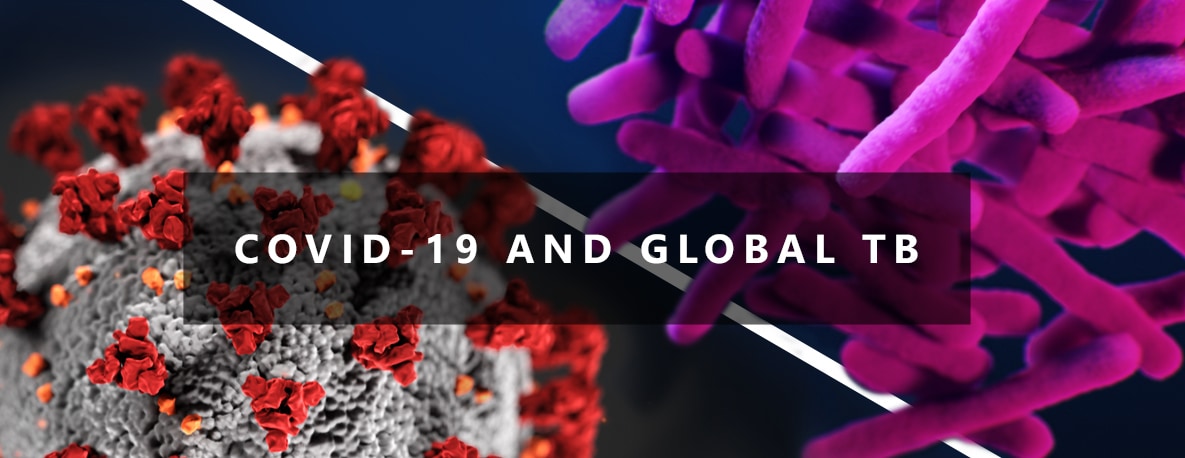
Program Key Considerations and Resources
CDC’s Division of Global HIV & TB (DGHT) in partnership with national governments is fighting tuberculosis (TB) on the frontlines in more than 25 high burden countries to find, cure, and prevent TB while helping sustain country efforts. The public health platforms that CDC and partners have built, as well as the innovative approaches to TB surveillance, treatment, prevention and infection control, have improved country-level and global health care systems. These same platforms are being leveraged in the fight against COVID-19.
Preventing Missed TB Cases While Fighting COVID-19
Increased demand for health care services due to COVID-19 can challenge health facilities and health care systems. Previous global and regional health emergencies, like Severe Acute Respiratory Syndrome (SARS) and Ebola virus disease, negatively impacted TB care. These challenges often resulted in disruption of TB health care services, delayed diagnosis and treatment and increased morbidity and mortality for patients with TB.
During the current COVID-19 pandemic, it is important that TB services are prioritized as essential, and that access to care is assured and effectively maintained to avoid a negative impact on TB care and adverse patient outcomes.
Recent modeling by the STOP TB Partnership highlights the devastating effect of the COVID-19 pandemic on global TB programs, which could result in an increase of approximately 6.3 million cases and 1.4 million more TB deaths by 2025. These experiences and data underscore the importance of maintaining the continuity of TB programs to ensure resources are in place to rapidly close gaps in TB diagnosis, treatment and prevention during this pandemic.
COVID-19 and TB share some common clinical features. Exposure to both diseases can occur simultaneously and the presence of comorbidities can result in poor outcomes. A positive test result for COVID-19 does not rule out the presence of TB disease, particularly in high TB burden settings. In these settings, implementation of simultaneous testing for both diseases is recommended for persons with respiratory symptoms, as noted by the World Health Organization (WHO).
TB Diagnosis During COVID-19
Sputum specimens for treatment follow-up should be collected in a safe location with specific instructions. For instance, collection of specimens should be done outside the home in open space away from others. Programs should be cognizant and vigilant about preventing negative impact on laboratory capacity, such as delays in performing HIV early infant diagnosis, viral load, and TB testing on the GeneXpert platform. Programs should also be encouraged to find alternative and innovative ways to ensure sputum specimens are collected for TB testing.
When testing for TB, the use of biosafety cabinets is recommended when handling sputum. However, if a cabinet is not available, the enforcement of all other requirements, such as consistent use of the N95 respirator, handwashing, use of gloves, goggles or protection shield, waterproof aprons, regular decontamination of surfaces, staff distancing in the laboratories, ventilated workplaces and safe transportation should be observed.
Severity of COVID-19 among TB Patients
Data on COVID-19 and TB are limited for adults and children. However, globally there is mounting evidence that patients with chronic respiratory diseases, including TB, are at increased risk of severe outcomes or dying from COVID-19. The risk and severity of coronavirus infection in young people with comorbidities such as TB is not fully known, although there is reason to believe that the presence of comorbidities may increase risk of symptomatic and severe disease in these children. Children with co-morbidities should be closely monitored for signs of severe disease. Globally, there have been interruptions in routine vaccination programs for children. In countries or settings with a high incidence of TB, Bacille Calmette-Guerin (BCG) vaccine, prevents severe forms of TB in children, including TB meningitis. There have been reports of diversion of this vaccine to support other populations from the effects of COVID-19. CDC and WHO encourage countries to prohibit diversion of BCG to non-prioritized populations. Use of BCG in non-prioritized populations should only be considered in sanctioned randomized clinical trials.
Safety in TB Health Facilities
It is likely that some patients with COVID-19, many of whom might be undiagnosed, will seek care at TB clinics. Robust implementation of infection prevention and control measures is critical to ensure the safety of health care workers and patients accessing care at health facilities. Respiratory infection control measures, in which TB programs are well-versed, are of even greater importance now, as are general precautions, such as frequent handwashing, disinfecting of surfaces, and avoiding touching one’s face. Respiratory infection control measures for COVID-19 that should be implemented or integrated into TB infection control measures include triage and early identification and separation of symptomatic patients, fast tracking or expedited service, implementation of droplet and contact precautions, frequent handwashing, environmental engineering controls and use of personal protective equipment. Programs should refer to CDC and WHO technical guidance on infection control measures in the context of COVID-19. Efforts should be made to minimize the amount of in-person patient contact at health care facilities to reduce the risk of infection to health care workers, as well as patients visiting these facilities. Multi-month drug supplies for TB patients on treatment and those on TB preventive treatment are a good alternative to ensure treatment continuity and completion. In settings where movement restrictions have been instituted, safe home delivery of medicines may be necessary. Use of alternative modalities such as community-based treatment monitoring or digital adherence interventions should be considered to monitor TB treatment and associated adverse events.
Resources
CDC
PEPFAR
STOP TB Partnership
- TB and COVID-19
- The Potential Impact of the COVID-19 Response on Tuberculosis in High-Burden Countries: A Modeling Analysis
WHO






















.png)











No hay comentarios:
Publicar un comentario